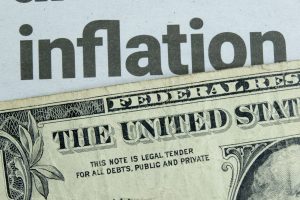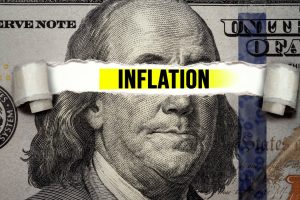Friday’s PCE report and the Fed … where Louis Navellier sees the market headed this summer … encouraging market breadth … another “commercial real estate watch” story
The Fed wants us to believe that interest rates are headed higher.
June’s decision by the Federal Open Market Committee to hold off on a hike came with a projection that another two quarter percentage point moves are on the way before the end of the year.
The Fed’s Dot Plot moved decidedly upward, pushing the median expectation to a funds rate of 5.6% by the end of 2023. Assuming the committee moves in quarter-point increments, that would imply two more hikes over the four meetings remaining this year.
Meanwhile, Federal Reserve Chairman Jerome Powell has sounded hawkish and supportive of these prospective hikes in his appearances after the FOMC decision.
In his post-FOMC press conference, Powell said, “inflation pressures continue to run high.”
And a day later, speaking before Congress, he noted that “nearly all” Fed policymakers “expect that it will be appropriate to raise interest rates somewhat further by the end of the year.”
But not everyone is convinced Powell & Co. will follow through
Our own Luke Lango is among that group of skeptics.
From Luke in his Daily Notes from Innovation Investor:
…The data shows that inflation is cooling faster than ever right now, with pretty much every leading indicator suggesting we will be back to the Fed’s 2% target by late summer, without the need for any more rate hikes.
The Fed will listen to this data. It’ll keep talking tough, but ultimately, it won’t hike again because inflation is crashing, and people are starting to lose their jobs (jobless claims remained at 12-month highs last week).
At the same time, the economy is turning around (in May, the Conference Board’s leading economic indicators index rebounded for the first time in this cycle).
Altogether, falling inflation, a dovish Fed pivot, and a rebounding economy are creating the foundation for a multi-year economic expansion and multi-year bull market.
This is and will remain a buy-all-dips market.
Now, there’s a disconnect here…
Luke is correct in pointing toward loads of data indicating that inflation is falling. And yet Powell keeps referencing inflation that’s “too high,” which is likely to result in more rate hikes.
How do we resolve these inconsistent positions?
Enter this Friday’s Personal Consumptions Expenditures (PCE) report.
The Core PCE report is the big one to watch because the Fed openly admits it’s their preferred inflation gauge
And the key detail that resolves the disconnect above is that Core PCE inflation hasn’t dropped as much as the other inflation metrics.
Below, we look at Core PCE dating all the way back to early 2021. What you’re going to see is that in November of 2021, Core PCE clocked in at 4.82%.
It then climbed as high as 5.42% in January of 2022 before saw-toothing in the months since.
Today, the figure comes in at 4.70%, which is only slightly below our starting value of 4.82% nearly 20 months ago (I’ve added the horizontal trendline to help you see this).
Plus, rather than falling, Core PCE reaccelerated at the last reading.
Friday brings us the latest data.
If Core PCE drops materially, watch for a jubilant market reaction, as it will take pressure off the Fed to hike in July. And if that happens, then Luke’s “buy-all-dips” approach should pay off handsomely.
If the data remain high, then the odds of Powell & Co. following through on their rate-hike rumblings increase.
We’ll let you know what happens on Friday.
Meanwhile, where does legendary investor Louis Navellier see the market going next?
In yesterday’s Special Market Update podcast from Accelerated Profits, Louis chimed in on where he sees stocks headed this summer.
From his podcast:
This is the end of the quarter. We tend to rally going into the end of quarters. We tend to rally going into July Fourth weekend. So, I expect a firm week.
After July Fourth, we might have a pause. And then, of course, [Q2] earnings season will be coming out. And it will be “every stock for itself.”
But while it might be “every stock for itself,” Louis is encouraged that more stocks are participating in the market gains.
Back to Louis:
If you look at the market at the end of April, seven giant tech stocks were hogging all the money. But at the end of May, there were 20 stocks in the S&P that accounted for all the gains, so the market was broadening out. Then in early-June, we got the big Russell realignment going on which led to a big small-cap surge.
It’s clear to me that even with recent distractions, the stock market is broadening out and our fundamentally superior stocks are attracting a lot of attention.
One way to see this broadening out of gains is by comparing the S&P 500 Index with the S&P 500 Equal Weight Index
To make sure we’re all on the same page, the S&P 500 Index is comprised of a shade more than 500 of the largest companies in the United States (503, to be exact).
However, all of these companies don’t get equal representation in the index. That’s because the S&P is “weight-averaged.” In other words, the bigger the company, the more “representation” it has in the index. Given this, when we look at the S&P, we’re not viewing an accurate depiction of how its average stock is performing.
For that information, we’d look at a different index – the S&P 500 Equal Weight Index. As the name implies, this gives us the equal representation we’re looking for.
Below, we compare the S&P Index (in black) and the S&P Equal Weight Index (in green) on the year. As you can see, the S&P has dominated its equal-weight counterpart.
But let’s zero in on what’s happened more recently – the “broadening” as Louis calls it.
Here’s how the two indexes have performed since June. As you can see, the equal-weight index (again, in green) has turned the tables and been outperforming the regular S&P.
As we look for evidence that this bull market has staying power, we want to see these broadening gains. And coming full circle to the Friday’s PCE report, if those data come in cooler than expected, watch out above. Even more broadening of gains should be in the cards.
Finally, let’s end on a slightly more cautious note as we look at the latest addition to our commercial real estate watch segment
Regular Digest readers know that for months, we’ve been running this segment to monitor this critically-important sector of the U.S. economy.
The same factors that resulted in a handful of banking failures this spring are creating cracks in the foundation of the $20-trillion commercial real estate sector. If defaults snowball, it will have an enormous impact on the U.S. economy.
Here’s Bloomberg from last week with the latest warning:
US office buildings are unlikely to regain their peak pre-pandemic values until at least 2040 as demand for desk space weakens, according to a forecast by Capital Economics.
Values are expected to plunge 35% from the peak by the end of 2025 and take an additional 15 years or more to recover as hybrid and remote work reshape real estate, the London-based research firm reported Thursday. It’s a trend that mirrors the collapse of shopping malls as e-commerce grew…
About $18 billion of office buildings were considered distressed at the end of March, MSCI Real Assets said in a report Thursday, estimating almost $43 billion of offices are at risk of default.
The Fed’s blistering rate-hikes over the last year are behind much of the pain. The higher borrowing costs have crushed the commercial real estate industry, which often relies on variable rate loans.
About $1.5 trillion in commercial mortgages are coming due over the next three years. They’ll have to be refinanced at such nosebleed levels that the numbers just won’t work anymore for many real estate companies.
If you have REITs in your portfolio, keep on eye on your exposure to malls and white-collar offices, specifically. Back to Bloomberg on this note:
Retail properties including malls were the most troubled type of real estate, with nearly $23 billion of distressed assets tied to the sector. About $18 billion of office buildings were considered distressed at the end of March, according to the report.
Offices, which are also struggling with weaker demand given the rise in remote work and job cuts, account for nearly $43 billion of potential distress, the most of any sector. Offices face a bigger wave of maturing debt while distress in retail “appears to be cooling,” the report says.
Overall, while we cross fingers for a cooler PCE report on Friday leading to a continuation of the broadening of market gains, just remember that it’s not a “stock market,” it’s a “market of stocks” – and real estate stocks continue to face headwinds.
We’ll keep you updated.
Have a good evening,
Jeff Remsburg




